The Ultimate Hospital Kitchen Cleaning Schedule for CQC Compliance in the UK
Master hospital kitchen deep cleaning procedures in the UK. Our checklist covers everything from PPE to audits for full NHS kitchen hygiene compliance.
Hospital kitchens aren’t just about dishing up a decent shepherd’s pie, they’re critical battlegrounds in the fight against infection. When patients are already under the weather with compromised immune systems, the last thing they need is a side helping of foodborne nasties.
That’s why having a rock-solid hospital kitchen cleaning schedule isn’t just good practice, it’s absolutely essential for meeting the standards and regulations set by the Care Quality Commission (CQC), the independent regulator of health and social care services in the UK. This guide will give you everything you need to keep your kitchen cleaner than a whistle and your inspectors as happy as Larry.
Why Hospital Kitchen Cleanliness is Crucial
Patient Health
Unclean hospital kitchens are ticking time bombs waiting to unleash foodborne horrors on the most vulnerable people. One dodgy bit of cross-contamination and you could have an outbreak on your hands. It’s not just needed for the patients either. Visitors and staff are also at risk when hygiene standards slip.
Infection Control
A properly sanitised kitchen is your front-line defence. Think of it as the firewall between food prep and clinical areas. Deep-cleaning techniques are essential for booting out persistent bugs like MRSA and COVID-19. These can linger on surfaces longer than an unwanted guest, so your cleaning game must be on point.
Legal Matters
UK hospital kitchens face scrutiny tougher than a well-done steak under legislation like the Food Safety Act (1990) and CQC standards. Failing inspections can lead to eye-watering fines or even shutdowns. Regulation 15 mandates that kitchens stay clean and documented − no paperwork, no compliance.
Reputation
As we’ve covered in a previous blog, a spotless kitchen boosts confidence and morale among patients, visitors and staff. It reflects the hospital's overall commitment to safety. Nobody wants to be known as “that hospital with the dodgy kitchen”.
Hospital vs. Restaurant Kitchens: Not All Clean Is Created Equal
Clinical Clean vs. Looking Clean
While restaurant kitchens may aim for “good enough to serve”, hospital kitchens need a clinical clean. Surfaces must be sanitised to sterile levels – it’s the difference between a wiped counter and a surgery-ready zone.
Heavy-Duty Cleaning Arsenal
Hospital kitchens use high-powered disinfectants that leave regular cleaning supplies in the dust. These are industrial-grade weapons against stubborn pathogens.
“Clean-as-You-Go on Steroids”
Hospital kitchens require around-the-clock cleaning vigilance. Equipment is scrubbed multiple times a day and tasks don’t stop when the dinner rush ends.
Higher Stakes
The consequences of a slip-up in a hospital kitchen are far more severe. A minor incident that might give a diner a tummy ache could seriously harm a recovering patient. The stakes couldn’t be higher.
Key Elements of a CQC-Compliant Cleaning Plan
Written Cleaning Policy and Schedules
If it’s not written down, it didn’t happen. You need detailed schedules for daily, weekly, monthly and annual cleaning prominently displayed and followed religiously.
Colour-Coded Cleaning Equipment
Stick to the national colour coding system. Green gear is for kitchens only, no exceptions. Cross-contamination starts with sloppy equipment use.
Documentation and Auditing
Cleaning logs with signatures and dates are essential. Keep risk assessments, COSHH sheets (Control of Substances Hazardous to Health) and checklists regularly reviewed and up to date.
Staff Training
Mandatory food hygiene and infection control training is non-negotiable. Keep records signed, dated and inspection-ready. Consider whether staff need to enrol for hygiene refreshers by getting a new food hygiene certificate.
Infection Control and Food Safety Practices
Hand hygiene, PPE (green gloves and aprons) and proper disinfection methods are core. Daily fridge checks and thermal disinfection of crockery are essential.
Cleaning Schedule Breakdown
Daily Cleaning Tasks at a Glance
- Food prep areas: Sanitise all countertops and tables thoroughly.
- Sinks and taps: Clean and disinfect until sparkling.
- Equipment: Sanitise all gadgets after use (ovens, blenders, toasters, etc.).
- Floors and bins: Mop floors daily and empty bins according to the NHS Trust Cleaning Policy.
- Temperature checks: Fridges (0-5°C), freezers (below -18°C) and sample fridge logs.
- High-touch points: Clean handles, switches and doorknobs.
- Crockery and utensils: Use disposable towels and ensure thermal disinfection.
- Handwashing stations: Keep stocked and fully functional.
Weekly and Periodic Cleaning Tasks
- Clean walls, ceilings and drains to prevent grime build-up.
- Deep clean appliances (including behind and inside).
- Empty and clean fridges/freezers, removing expired food.
- Check thermometer and scale accuracy.
- Clean ventilation systems, which may require professional help.
- Monthly tasks include storage room deep cleans, pest control and schedule reviews.
- Quarterly or annual tasks involve HVAC filters, refresher training, and professional extraction unit cleaning.
7 Steps to Create a Hospital Kitchen Cleaning Rota
Step 1: List All Cleaning Tasks
Identify every surface, area and piece of equipment requiring cleaning, including high-touch points, appliances, storage and waste areas.
Step 2: Categorise by Frequency
Group tasks into daily, weekly and monthly timeframes based on risk and usage.
Step 3: Assign Responsibilities
Allocate each task to specific staff members, ensuring everyone knows their duties. Rotate responsibilities for fairness and comprehensive training.
Step 4: Create a Clear, Accessible Rota
Design a table format with task, frequency, responsible person and completion columns. Display it prominently in the kitchen.
Step 5: Specify Methods and Precautions
Outline specific cleaning methods, required PPE and special precautions like colour-coded equipment usage. Follow the manufacturer’s instructions religiously.
Step 6: Record Keeping and Auditing
Staff must log completed tasks with dates and initials. Review logs regularly for compliance and keep them for Environmental Health Officer inspections.
Step 7: Review and Update Regularly
Update rotas to reflect changes in kitchen layout, equipment or staffing. Review effectiveness during audits or after incidents.
Common Cleaning Mistakes to Avoid
Neglecting hard-to-reach spots: Bacteria throw parties in hidden areas, such as behind ovens and under counters. Don’t let them get comfortable…
Skipping scheduled cleans: Letting cleaning slide when things get busy is like playing Russian roulette with hygiene standards.
Incorrect equipment usage: Using the wrong cloths leads to dangerous cross-contamination. Stick to the colour coding system.
Ignoring PPE: Not wearing appropriate gloves and aprons is a significant safety oversight that inspectors won’t tolerate.
Disregarding manufacturer guidelines: Failing to follow cleaning product instructions reduces effectiveness and poses risks.
Procrastinating deep cleans: Waiting until problems are obvious means it’s often too late to prevent serious issues.
Making Your Checklist Work: Practical Tips for Success
Accountability: Put names against tasks. When everyone’s responsible, no one’s responsible.
Visibility: Display cleaning schedules where staff can’t miss them, not tucked away like a guilty secret.
Standardisation: Use colour-coded cleaning gear consistently - green for kitchens, always.
Record keeping: Maintain meticulous logs for auditing and inspection purposes as paper trails can save the day.
Continuous improvement: Review your cleaning checklists regularly and adapt to changes. Address cleaning shortfalls promptly and ensure regular monitoring.
Expert support: Consider professional advice from companies like KDC Food Hygiene Ltd for robust cleaning schedules and deep cleans that meet hospital standards.
Wrap Up: How We Can Help
Maintaining spotless hospital kitchens isn’t just about keeping things tidy – it’s about life-saving hygiene and strict CQC compliance.
At KDC Food Hygiene, we specialise in deep cleans and creating robust schedules for hospital settings. Contact us today for a free consultation so we can make sure your kitchen is cleaner than a whistle. Because when it comes to hospital hygiene, there’s no room for cutting corners.














